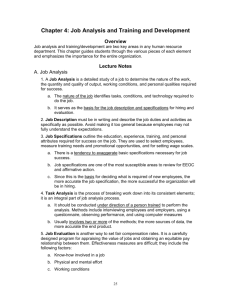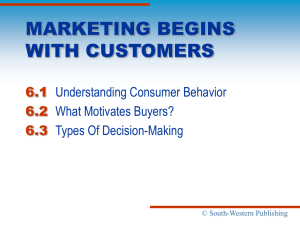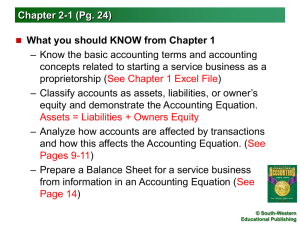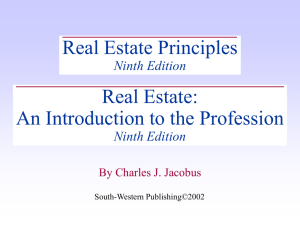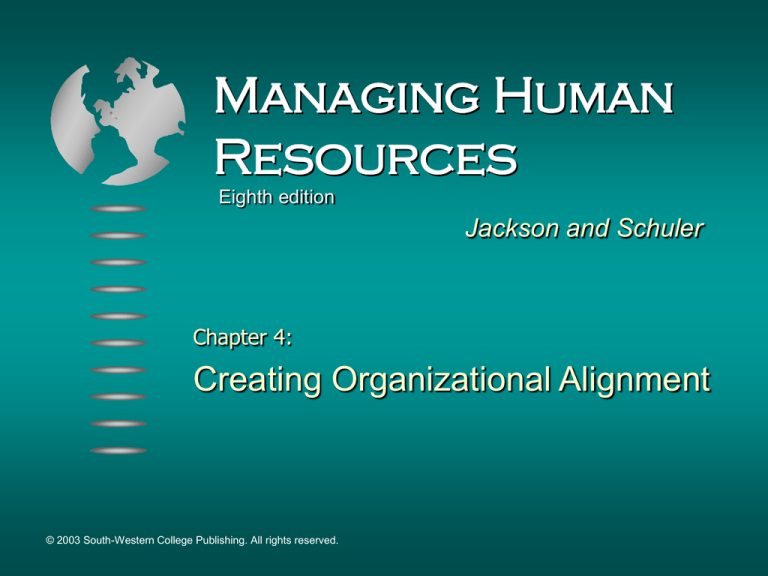
Managing Human
Resources
Eighth edition
Jackson and Schuler
Chapter 4:
Creating Organizational Alignment
© 2003 South-Western College Publishing. All rights reserved.
Chapter Outline
Strategic Importance of the Organization
Environment
Company Leadership: Vision, Mission, and
Values
Strategy
Organization Structure
Organizational Culture
Partnership Roles for Creating Organizational
Alignment
© 2003 South-Western College Publishing. All rights reserved.
4–2
Strategic Importance of
Organizational Environment
Organizational environment includes:
Company leadership
Corporate and business strategies
Organizational structure
Organizational culture
HR practices should be aligned with other
aspects of environment.
© 2003 South-Western College Publishing. All rights reserved.
4–3
Company Leadership
Vision
Top management’s view of the kind of company it
is trying to create.
Mission
Defines a company’s business and provides a clear
view of what the company is trying to accomplish
Provides guidance to fulfill the vision.
© 2003 South-Western College Publishing. All rights reserved.
4–4
Leadership
Values
Are strong enduring beliefs and tenets
that the company holds dear.
Differentiate the company from other
companies.
State how employees are expected
to behave.
© 2003 South-Western College Publishing. All rights reserved.
4–5
Leadership (cont’d)
The vision, mission, and values convey to
employees answers to questions such as:
Where are we going?
Why are we going?
How will we get there?
HR professionals participate in the creation,
maintenance and revision of vision, mission,
and values statements and develop practices
to support them.
© 2003 South-Western College Publishing. All rights reserved.
4–6
Examples of Vision Statements
“To become the world’s most respected service
brand.”
—American Express
“We want to be the world’s No. 1 hospitality
provider.”
—Ritz Carlton
© 2003 South-Western College Publishing. All rights reserved.
4–7
State Farm Insurance Mission Statement
At State Farm Insurance, the mission is to:
Provide quality insurance products
Offer friendly policyholder service
Settle claims fairly and quickly
Charge reasonable rates for our insurance products
Maintain financial stability to fulfill our commitment to
our policyholders
Uphold the State Farm marketing partnership
© 2003 South-Western College Publishing. All rights reserved.
4–8
State Farm Values Statement
Providing customers with the best possible
service and value
Building lasting relationships among
customers, agents, employees and
communities through respect, understanding,
and mutual trust
Being financially strong
Keeping promises by always dealing fairly and
with integrity
© 2003 South-Western College Publishing. All rights reserved.
4–9
Strategy
A set of integrated and coordinated
commitments and actions intended to achieve
a stated goal.
A guide for action that is closely linked to the
nature of the business.
© 2003 South-Western College Publishing. All rights reserved.
4–10
Levels of Strategy
Corporate Diversification
Business-Level Competitive
Functional
© 2003 South-Western College Publishing. All rights reserved.
4–11
Developing a Competitive Strategy
Firms vary on how they approach strategy:
Some strategies reflect the founder’s intuitions and
passions.
Others are based on systematic analysis.
© 2003 South-Western College Publishing. All rights reserved.
4–12
Developing a Competitive Strategy
(cont’d)
SWOT Analysis:
Strengths
Weaknesses
Opportunities
Threats
© 2003 South-Western College Publishing. All rights reserved.
4–13
Competitive Analysis
Five-Forces
Model
(Porter)
New Entrants
The Firm
Suppliers
Buyers
Existing
Rival Firms
Identifies Threats
And Opportunities
Substitute Products
© 2003 South-Western College Publishing. All rights reserved.
4–14
Questions to Ask About Competitors
What drives the competitor?
What is the competitor’s current strategy and
what strategy could it adopt?
What assumptions does the competitor make
about the industry?
What are the competitor’s capabilities?
© 2003 South-Western College Publishing. All rights reserved.
4–15
Competing for Labor
Systematic use of competitive analysis for
understanding the competition for labor isn’t
widely used.
Benchmarking
Identify “industry leaders”
Analyze “best practices”
Transfer best practices to own organization
Usually a collaborative effort focusing on specific
HRM aspects
© 2003 South-Western College Publishing. All rights reserved.
4–16
Assessing Strengths and Weaknesses
Resources:
Tangible assets
Intangible assets
Unique resources
Capabilities:
Integration of
resources
Core Competencies:
Unique knowledge
Sustained competitive
advantage
© 2003 South-Western College Publishing. All rights reserved.
4–17
Aligning HRM for Organizational Learning
Organizational
Environment
for Learning
Organizations
•
•
•
•
Leadership
Strategy
Culture
Design and
Structure
Managing
Human
Resources to
Support
Continuous
Learning
• Staffing
• Training and
Development
• Performance
Appraisals
• Rewards
© 2003 South-Western College Publishing. All rights reserved.
Needed
Behaviors
Learning Orientation
and Capacity
• Think critically
• Create new
knowledge
• Learn from others
• Work across
boundaries
4–18
Four Types of Competitive Strategy
Desire for
Low Cost
Desire for
Something Unique
Broad
Target
Market
Cost Leadership
Strategy
Differentiation
Strategy
Narrow
Target
Market
Focused Cost
Leadership
Strategy
Focused
Differentiation
Strategy
© 2003 South-Western College Publishing. All rights reserved.
4–19
Behavioral Imperatives for
Alternative Strategies
Innovation
• Experimentation
• Risk Taking
• Project
Management
• Teamwork
Total Quality
• Responsiveness
to customers
• Problem Solving
• Quality
Standards
© 2003 South-Western College Publishing. All rights reserved.
Low Cost
• Efficient Production
• Lower Labor Costs:
• Part-time/shift work
• Repetitive work
• Minimum benefits
• Reengineering
4–20
What Does Quality Mean?
In Products:
Performance
Features
Reliability
Conformance
Durability
Serviceability
Aesthetics
Perceived quality
© 2003 South-Western College Publishing. All rights reserved.
In Services:
Tangibles
Reliability
Responsiveness
Assurance
Empathy
Insight
Problem-solving
4–21
Organization Structure
The allocation of tasks and responsibilities
among individuals and departments to support
the firm’s strategy.
Departmental structure
Divisional structure
Matrix
Process-based horizontal
Network
© 2003 South-Western College Publishing. All rights reserved.
ABC, Inc.
4–22
Departmental Structure
Characteristics:
Based on functions: marketing, production, and
other activities
Focused on specialized knowledge
Maintaining coordination may be difficult as firm
grows.
Provides clear paths for
advancement
© 2003 South-Western College Publishing. All rights reserved.
4–23
Divisional Structure
Characteristics:
Based on product lines, customer markets or
geographical locations
Encourages cross-functional work
Creates duplication of support functions
© 2003 South-Western College Publishing. All rights reserved.
4–24
Matrix Structure
Characteristics:
Dual reporting to functional and divisional heads;
lines of authority may be ambiguous
Employees are shared across organizational units
Facilitates organizational learning
© 2003 South-Western College Publishing. All rights reserved.
4–25
Process-Based Horizontal Structure
Characteristics:
Flat hierarchical structure
Use of teams
Quick and continuous improvement
Broad skill development
Fits Total Quality Management (TQM) and process
reengineering approaches
© 2003 South-Western College Publishing. All rights reserved.
4–26
Organization Design
Organizational Processes:
Total Quality Management
Baldrige Award
ISO 9000 Standards
Employee Empowerment
Process Reengineering:
New ways to get work done
Examine breadth and depth of change
© 2003 South-Western College Publishing. All rights reserved.
4–27
Network Structure
Characteristics:
Many outsourced activities
Uses information technology for coordination
Facilitates constant change and adaptation
Challenge to manage and control
© 2003 South-Western College Publishing. All rights reserved.
4–28
Structures That Cross Country Borders
International Structure
Separate group responsible for international
activity
Global Product Structure
Expand by offering new products/services
Global Regions Structure
Group activities by similar economies, cultures
Transnational Structure
Matrix structure based on products & regions
Manage teams across borders
© 2003 South-Western College Publishing. All rights reserved.
4–29
Coordinating with Global Teams
Facilitate coordination among product/regional
units
Members may be from same or different
departments.
Formal, informal, same or multi-level groups
May include people from other companies
HR information management systems
improve coordination and consistency
© 2003 South-Western College Publishing. All rights reserved.
4–30
Organizational Culture
The unique pattern of shared
assumptions,
values
norms
that shape the
socialization activities
language, symbols
rites and ceremonies
of people in the organization.
© 2003 South-Western College Publishing. All rights reserved.
4–31
Organizational Culture (cont’d)
Flexible
Formal
Control
Orientation
Clan
Culture:
Entrepreneurial
Culture:
Tradition, loyalty,
commitment, teamwork, socialization
Risk-taking,
creativity, dynamism
Bureaucratic
Culture:
Market
Culture:
Formalization, rules,
procedures,
hierarchy
Financial goals,
competitiveness,
profits orientation
Stable
Internal
External
Focus of Attention
© 2003 South-Western College Publishing. All rights reserved.
4–32
Organizational Subcultures
May arise from differences among:
Firms that merge
Demographic groups
Occupational groups
National and regional groups
Industries
© 2003 South-Western College Publishing. All rights reserved.
4–33
Hofstede’s Dimensions of
Industry Culture
Employee-oriented versus results-oriented
Parochial versus professional
Open versus closed
Loose control versus tight control
© 2003 South-Western College Publishing. All rights reserved.
4–34
Strategic Importance of Culture
Strong Cultures
Provide clear guidelines for behavior
Can enhance performance when they match
strategic objectives
Must be in sync with
stakeholder expectations
© 2003 South-Western College Publishing. All rights reserved.
4–35
Partnership Roles for Creating Alignment
Line Managers:
• Build Culture
• Understand
structure
• Develop an
empowered
workplace
• Ensure
internal
alignment
HR Professionals:
• Align HR with
vision mission
and values
• Support
organizational
culture
• Work with line
managers to
support strategy
• Monitor
alignment
© 2003 South-Western College Publishing. All rights reserved.
Employees:
• Contribute to
mission
• Adapt to culture
• Develop skills to
support strategy
• Keep
organizational
goals in mind
• Assist in job
redesign
• Monitor own
needs
4–36

